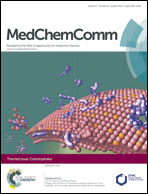Elucidating structural features of an entirely carbohydrate cancer vaccine construct employing circular dichroism and fluorescent labeling
Abstract
The zwitterionic polysaccharide PS A1 from anaerobe Bacteroides fragilis ATCC 25285/NCTC 9343 is known to elicit a T-cell-dependent, major histocompatibility complex class II (MHCII) immune response through a correspondingly similar protein–antigen-based mechanism/pathway. The biological activity of PS A1 is known to arise from alternating charged motifs on adjacent monosaccharides comprising a tetrameric repeating oligomeric unit creating an alpha-helical secondary structure. However, we have learned that this alpha-helical structural characteristic may not play a role in immune activation. Paradoxically, our current knowledge of structure–activity relationships (SARs) with electrostatically charged polysaccharides has become more clearly defined, yet a lack of tools/probes for measuring dynamic structural changes hinders progress in carbohydrate-based vaccine development. Site- and region-specific structural modifications of PS A1, followed by conjugation with a known carbohydrate cancer antigen, the Thomsen-nouveau (Tn = alpha-D-GalNAc-OSer/Thr) antigen, does not alter antibody isotype switching ability and leads to specific IgG3 antibodies in C57BL/6 mice. Circular dichroism (CD) and studies using fluorescently labeled PS A1, described herein, reveal information pertaining to structure–activity relationships and the nature of Tn conjugation to chemically modified PS A1. The CD spectra of a Tn–PS A1 construct at 8.5 ≥ pH ≤ 3.5 illustrates complete loss of alpha-helical character while spectra obtained in the 3.6 ≤ pH ≥ 8.4 range denotes minimal alpha-helicity in comparison to naturally occurring PS A1. Temperatures exceeding 60 °C reveal complete loss of helical character. Two methods for Alexa Fluor488® fluorescent labeling studies of chemically oxidized PS A1 have given rise to percent conjugation values (% loading) calculated to be on average 35 Tn molecules bound. Combined, our results argue that altering the structure of PS A1, without chemically modifying the electrostatic charge character, does not alter immune response/recognition in mice. These findings have important implications for the design of entirely carbohydrate-based vaccine constructs.


 Please wait while we load your content...
Please wait while we load your content...